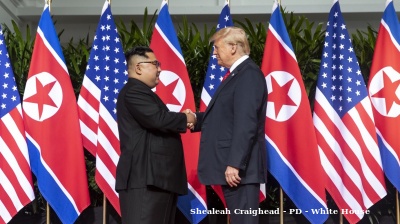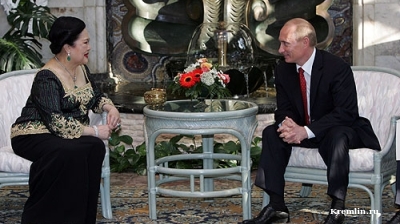Ukrainian President Volodymyr Zelenskiy says Russia’s widely anticipated battle of the Donbas in eastern Ukraine has begun, as reports of heavy fighting and a Russian assault rolled in the evening of April 18.
Zelenskiy said a “significant part” of the Russian army was now poised to try to take control of eastern regions in Ukraine. In a video address he said Russian troops had begun the battle for Donbas, “for which they have been preparing for a long time… No matter how many Russian troops are driven there, we will fight. We will defend ourselves. We will do it every day.”
On the same day the steel works in the southern port town of Mariupol was struck and that has been the last hold-out of Ukrainian defenders. The Ukrainian fighters there refused a Russian ultimatum the previous day and vowed to “fight to the last drop of blood.”
The western city of Lviv was also struck by four cruise missiles and saw its first civilian deaths. The city, which is close to the Polish border, has been a major staging post for both military and civilian aid flowing into the country since the conflict began over 50 days ago.
Zelenskiy in his daily video address repeated his call for more heavy weapons, describing “every delay” as “permission for Russia to take the lives of Ukrainians”. In his latest address, he appealed to countries to send arms, and indirectly criticised Germany, by adding that some countries had been “holding back,” and that Ukraine’s fate “depends upon them”.
Russia has moved 11 new battalion tactical groups into the east and south of Ukraine in recent days, preparing heavy artillery, aviation and other military assets, and has directed more troops into the region. Russia has spent more than three weeks pulling troops away from Kyiv to bolster the ranks poised to attack eastern cities. Moscow has also brought fresh forces from Belarus to focus on the eastern front, according to US intelligence reports, as the Russian military is now concentrated on taking control of the Donbas as part of its Phase 2 of its operation.
The first heavy weapons from the latest $800mn package promised by the US arrived in the last days in Ukraine and will be thrown into the fight, but Kyiv is keeping up maximum pressure on the West as it faces the prospect of a major set-piece military battle, where it will confront the Russian army head on rather than in skirmishes and urban warfare, where the local defenders have the advantage.
The Russian troops around Kyiv have withdrawn back into Belarus, but they have been replaced by fresh Spetsnaz troops, according to reports.
There were also reports of the deployment of fighter jets and bombers attacking parts of Donbas on April 18. Until now Russia has not made full use of its superior airpower and has relied more on shelling and cruise missiles to hit infrastructure, military and, increasingly, residential targets. Cities like Mariupol have been flattened Russia artillery, whereas other less strategically important cities have been hit by targeted and selective missile attacks to create an atmosphere of terror across the entire country.
Peace talks hit an impasse
There was some optimism that a ceasefire deal could be reached after the Ukrainians issued a ten-point list of peace proposals on March 29 in Istanbul that contained several compromises. But the talks seem to have ground to a halt in the last week as each side hardened their position.
Zelenskiy reaffirmed last week that Ukraine will not compromise on its territorial integrity, whereas earlier he suggested that he was prepared to put the issue of deciding the fate of Crimea and the Donbas off in order to conclude a ceasefire and floated the option of holding a country-wide referendum on their status at some point in the future.
Previously the peace talk teams agreed to put aside the thorny question of territorial status of the disputed regions for a later face-to-face meeting between Putin and Zelenskiy and concentrated on other points where there was common ground. However, many analysts believe that the Kremlin is not prepared to concede on any of its positions and that its demands were simply ultimatums. Having rejected Kyiv’s offers of compromises, the Kremlin is now following through with Russia’s step-by-step strategy of simply escalating the violence at each stage until Kyiv eventually caves in.
Mariupol
The change in pace was also visible in the battle for Mariupol, which has been under heavy Russian bombardment for almost a month. Video footage shared on social media appeared to show a large missile or bomber attack on the steel mill where Ukrainian defenders have been holding out, desperately fighting against Russian forces, surrounded and outnumbered, unable to resupply or get their wounded out.
Russian forces set an ultimatum for the defending Ukrainian forces held up in the Azovstal metal works to surrender by 6am on April 17, and they would be given safe passage if they did, but they refused to do so.
In his evening address on April 16 Zelenskiy described the situation in Mariupol as “inhuman” and accused Russia of “deliberately trying to destroy everyone” there.
Moscow has been trying to take the strategically important port city that would link Russia’s mainland with Crimea via a “land bridge”, but has faced fierce resistance from local defenders, including many from the right-wing Azov forces. The Russian forces have been unable to oust the defenders from the steel mill on the outskirts of the city. There are reportedly more than 100,000 civilians trapped in the city.
Zelenskiy told Ukrayinska Pravda that the situation was “very difficult” in Mariupol. “Our soldiers are blocked; the wounded are blocked. There is a humanitarian crisis … Nevertheless, the guys are defending themselves.”
“I am Serhiy Volyna, Commander of the 36th Separate Marine Brigade named after Rear Admiral Mykhailo Belinsky, am addressing to you from the besieged Mariupol. We will not give up and will fight to the end,” the leader of the defence forces tweeted earlier in the day posting a photo of himself together with Zelenskiy.

The Russian forces have been unable to dislodge the 36th Separate Marine Brigade force. Unconfirmed reports alleged that Russia used chemical weapons during the previous week, but the Brigade has successfully resisted all attempts to dislodge them. The mayor of Kyiv has already renamed one of the squares in the capital “Heroes of Mariupol.”
“But our loyalty to the oath was not enough to liberate Mariupol. We need heavy weapons. It is in the power of the EU and the US to provide it to us. Heavy weapons for the defenders of Mariupol will save the Ukrainian military group,” Volyna continued. “Mariupol can be saved. We are ready to fight to the last drop of blood. But we must know that the world has done everything possible for this. Then we are ready to do even the impossible for our country. 18.04.2022. Serhiy Volyna.”
Volyna earlier posted a picture of himself and a letter he wrote to the Pope asking him to intercede on Ukraine’s behalf. Some analysts ascribed the strike on Lviv as revenge for the extremely embarrassing sinking of the Black Sea flagship cruiser Moskva at the weekend, a major blow to Moscow’s prestige that has caused outrage in Russia.
Lviv first civilian deaths
The previously relatively calm western city of Lviv also came under bombardment at 8am on the same day and saw its first civilian deaths. Four cruise missiles struck the city and shattered the peace there, as life had slowly been getting back to normal.
Three military installations were hit as well as a workshop in the centre, where at least four civilians were killed according to reports. Initial reports say the missiles came from the east and possibly from the Caspian Sea.
Lviv has been playing a vital role as a logistical hub for both humanitarian and military aid from the West.
In a rare statement the Russian Defence Ministry said an estimated 23,000 Ukrainians were dead and released their names. Zelenskiy earlier claimed that 3,000 Ukrainian soldiers had died.
Russia says that under 2,000 of their troops have died, whereas the Ukrainian intelligence says around 20,000 Russian soldiers have died and independent experts estimate the Russian deaths at somewhere around 15,000.
The United Nations refugee agency said 4,869,019 Ukrainians had left the country since Russia invaded in February as of April 18 – up 32,574 from the April 17 total, the UN High Commissioner for Refugees chief, Filippo Grandi, said as reported in the Guardian.
The US administration is watching events closely and a senior advisor to US President Joe Biden said that the US was contemplating entering the fray, and might commit troops to the fighting.
The talk has turned to a possible tactical nuclear strike against Kyiv. Washington has said that use of nuclear weapons would be a game-changer, but analysts say that a small 1 kilo tonne nuclear warhead used against Kyiv would decimate about one kilometre radius of the capital, but would probably not provoke a Nato response, as the West doesn't possess such small tactical nuclear weapons and a retaliation with larger nuclear weapons would rapidly escalate into a full-scale nuclear exchange.
In happier news on the same day as the battle for Donbas started, Matti Maasikas, the Ambassador of the European Union to Ukraine, accepted answers to a questionnaire from the European Commission that will kick off Ukraine’s application to join the EU, which was submitted only ten days earlier. Zelenskiy has been hounding the EU for a concrete date when the country could begin the formal process of joining the European trade club but had been met with a stony silence. The silver lining of the current conflict is that the EU may overcome its hesitancy and allow the Ukraine to join the EU – the only really successful reform programme for any of the Former Soviet Union (FSU) states and which has transformed the economies and dramatically lifted the standard of living of citizens of any country that has successfully joined the club.
News

Trump would like to meet North Korea’s Kim Jong Un during Asia trip
The prospect of renewed diplomacy between Washington and Pyongyang has lingered since Kim’s remarks last month suggesting a willingness to speak to the outside world.

Bill Gates makes surprise Indian TV debut
In a move set to spark both intrigue and curiosity, Microsoft co-founder and philanthropist Bill Gates has made a cameo appearance on Indian television, entering the iconic drama series Kyunki Saas Bhi Kabhi Bahu Thi 2.

Queen Sirikit of Thailand dies
The death of Queen Sirikit of Thailand has marked the end of an era for the Thai monarchy. According to an official statement from the Bureau of the Royal Household of Thailand, Her Majesty died at 9.21 pm on October 24.

Pakistan, the latest in Asia to see gold prices plummet
In international trading, the precious metal lost $35 per ounce to settle around $4,115, extending a week-long slide triggered by shifting expectations over US monetary policy.
_1761305900.jpg)



